Posture and Gesture #
Introduction #
Among many other effects, sensitivity to posture and gesture are greatly enhanced by 5-HT2A receptor agonists such as daime.1 I have made some study of static poses that align with the current of reverence. 🔬 Before detailing my findings, I want to emphasize that I have not made an exhaustive search. There may be other postures and gestures worth exploring. Furthermore, I have not studied dynamic poses (e.g., mimicking the flapping and soaring of eagle wings with your arms 🪽). The postures listed here are intended as static poses to be held steadily for a few minutes at a time. The reason that this article is under Santo Daime and not a generic Postures and Gestures page is because these poses have much greater significance when implemented by a whole group of people simultaneously in careful coordination. Posing solo is a bit self-indulgent.
Precedent #
See How to Stand from the Saint Michael work, p. 39-40. Why this gesture and not some other? What is the significance of this gesture? Unfortunately no rationale is given. About all we can gather from this passage is acknowledgment that posture is important.
Crossings #
There is a tradition of not crossing arms or legs. However, I distinguish the joint of the crossing. Wrist crossings are fine, but not crossed arms. Similarly, ankle crossings are fine, but not knee or ankle/knee crossings. I do not see any problem with standing on one leg, from a crossing perspective.
Multitasking #
I have tried to do both at the same time, holding a pose while singing hymns. It seems like too much to keep track of except for the most trivial cases. Probably the best chance for serious posing is when not singing or during a pause in hymns.
Doubts? #
Maybe you read through this page and you’re skeptical. Drink more daime. 🍵
Current of Reverence #
The analogy that I am trying to invoke is with electrical current or water flowing through a pipe. 🌊 Here, the substance that is flowing is reverence, and with enough daime, it feels almost tangible. Just as with electricity or water, there is a direction of flow. You receive reverence, it flows through you, and then you can direct it away from you. An arbitrary careless posture does not necessarily obstruct the current of reverence, but specific intentional postures can increase the conductance and encourage the flow. 🚰
Key #
 correct, energetically enlivening
correct, energetically enlivening
 incorrect, dull
incorrect, dull
Component-wise #
Before I list ensemble poses, I present the optimal positions of each relevant joint.
Receiving #
-
Spine extension
action sitting standing evaluation neutral 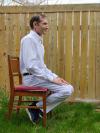
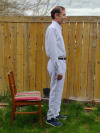

extension 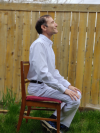
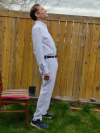

When sitting, there isn’t much difference in outward appearance, but I feel like I am arching my back. I cannot avoid lifting my chin, but the important part is to arch the back.
-
Rotate the wrist away from neutral
action before after evaluation pronation
(palm down)


neutral 


supination
(palm up)


-
Pinky extension
before after evaluation 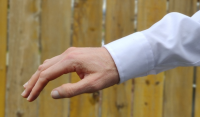
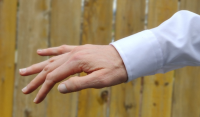

The nearby fingers are hard to isolate from the pinky extension, but the pinky is what I’m thinking about.
Sending #
- Wrist extension
action illustration evaluation extension 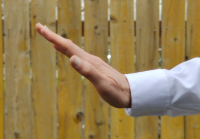

neutral 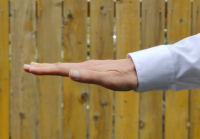

flexion 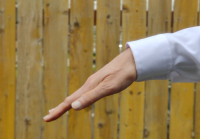

- Palm direction
Energy is emitted perpendicular to the palm surface. Your palm can be aimed at the center of the salão, perpendicular to the center of the salão (e.g. ceiling, floor, or along the circumference), or back toward yourself. In general, the most delicate direction is toward the center of the salão because it can look as if you are aiming across the salão at other people. If you are aiming across the salão then you must have consent; it should be an orchestrated collective action. If you are aiming elsewhere then consent is less important.
Pose Ensembles #
None of these pose ensembles incorporate all of the components mentioned above, but all of them incorporate some of the components. I also call out similar poses that miss opportunities to improve the conductivity of reverence.
Pose: Umbrella ☂️ #
| sitting | evaluation |
|---|---|
 |
 |
- Wrist and pinky extension
- Wrist pronation
- Palm facing ceiling
Variations:
- Both arms (“double umbrella”?)
- Different angle (shoulder joint can rotate about 90 degrees so play with that)
Of course, it is challenging to keep an arm (or arms) elevated for a long duration, but five minutes is feasible.
Pose: Feather ruffle 🪶 #
| sitting | evaluation |
|---|---|
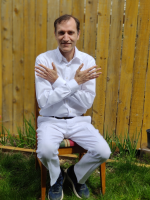 |
 |
- Wrist and pinky extension
- Wrist supination
- Palm facing self
The wrist extension prevents my hands from touching my arms or the shirt.
Variation: Straighten the elbow joint and face the palms toward the floor with the wrists crossed.
Pose: Classical worship #
| sitting | standing | evaluation |
|---|---|---|
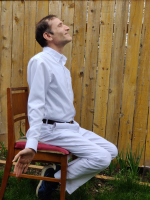 |
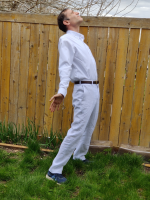 |
 |
- Spine extension
- Wrist supination & extension
- Pinky extension
- Palm facing the center of the salão
While I feel the inner effect of the pose, my external appearance looks a little bit odd (to me, at least :-). Compare with some artistic renditions:
| sitting(-ish) | standing |
|---|---|
 |
 |
The man (left) is a speed painting by Lance Brown. 🤩 The woman (right) is a photo of artwork from the Ashland OR salão. She lacks obvious spine extension, her wrist extension is faint, and her pinky extension is washed out by the flow of energy, but otherwise it is almost a great example.
| standing | evaluation |
|---|---|
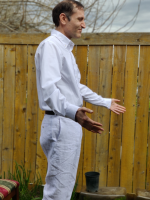 |
 |
- Wrist neutral/flexion instead of extension
- Pinky neutral instead of extension
- No spine extension
The following pose is a minor variation (different arm position) but otherwise the same idea:
| standing | evaluation |
|---|---|
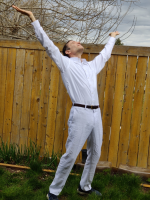 |
 |
- Spine extension
- Wrist and pinky extension
- Palm facing ceiling
With hands raised, this pose is too taxing to hold for more than a brief time…unless you’re a statue.
| front | side/front | side/back |
|---|---|---|
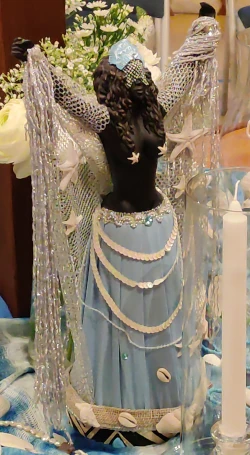 |
 |
 |
In celebration of Yemanjá, Ashland OR salão displayed this exquisite statue in 2023 & 2024. Spine extension is clearly evident from the side/back perspective. The right hand is balled in a fist, perhaps to hold a maraca (not sculpted). The left hand is cupped (flexion not extension), but I’ll cut the artist some slack. Wow. 😍
Pose: Holding a Flower 🥀 #
| concept | actual | evaluation |
|---|---|---|
 |
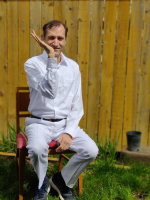 |
 |
- Wrist and pinky extension
- Palm facing perpendicular to the center of the salão
In the concept image, there is a flower superimposed over my arm/hand. Moving the fingers is like wiggling the petals.
Variation: By relaxing the humerus to a more neutral position, this gesture becomes a one-armed version of the Añjali Mudrā.
Wide acceptance of the two-handed Añjali Mudrā is based on a misinterpretation. The two-handed version is not the gesture. Two people together assembling the Añjali Mudrā with one hand each is the gesture.
Standing-only Pose Ensembles #
Pose: Shark fin 🦈 #
| Pose | Evaluation |
|---|---|
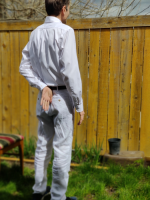 |
 |
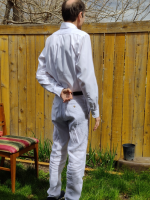 |
 |
- Wrist and pinky extension
- Palm facing perpendicular to the center of the salão
Pose: Hands with opposite twist #
| Closed | Open | evaluation |
|---|---|---|
 |
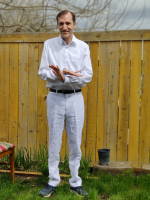 |
 |
- One wrist supinated, the other pronated
- Wrist and pinky extension (at least one hand)
- Palm facing palm or perpendicular to the center of the salão (ceiling and floor)
The open and closed variations just indicate whether the palms are facing or not.
Status #
Even without group consensus, I use variations of umbrella, feather ruffle, holding a flower, and shark fin in almost every work. These gestures are innocuous and do not prompt correction from the guardians.
Parody? #
Notes #
-
In contrast, in an ordinary state of mind, pose seems to have little psychological effect. See Garrison, K. E., Tang, D., & Schmeichel, B. J. (2016). Embodying power: A preregistered replication and extension of the power pose effect. Social Psychological and Personality Science, 7(7), 623-630. ↩︎
